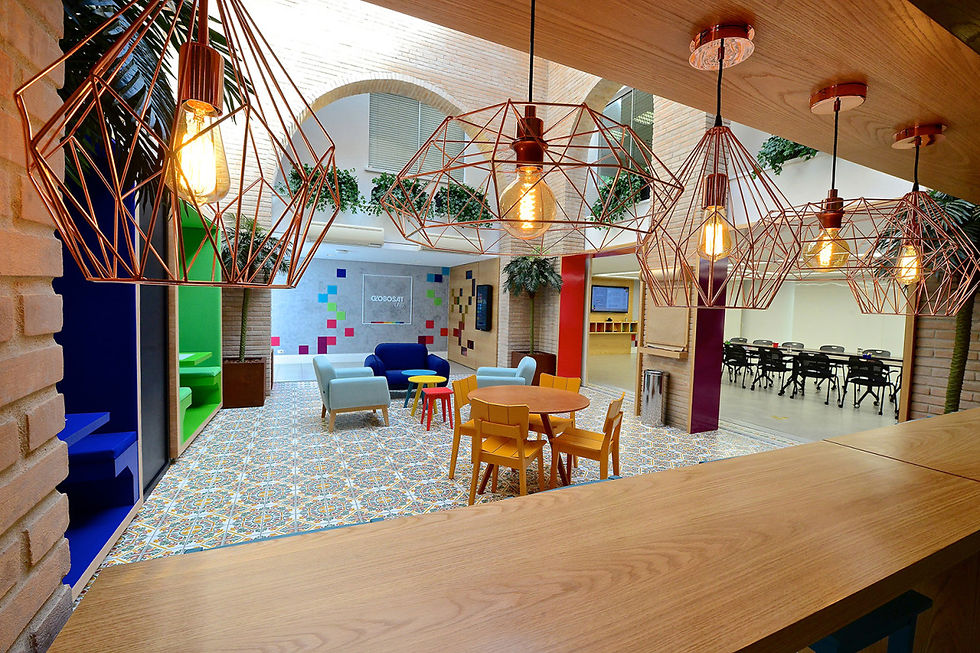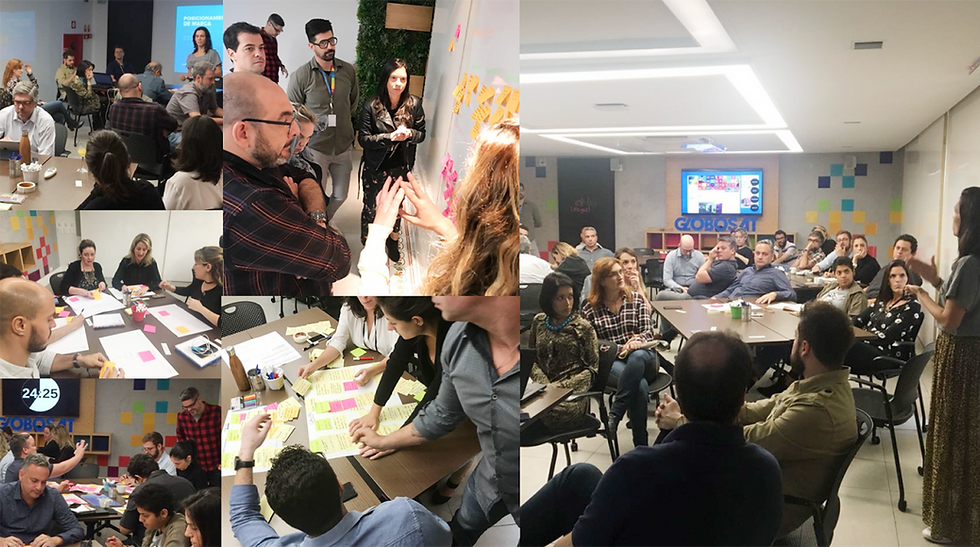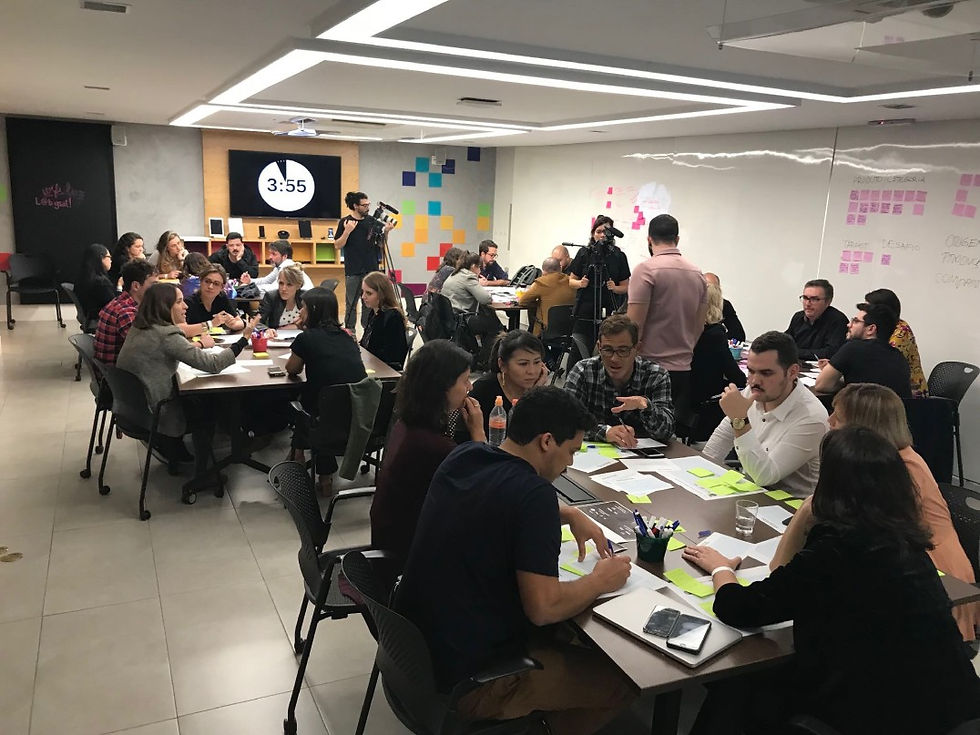A Brazilian Pay TV company tackles digital transformation through design processes
- Marcio Leite
- 24 de mar. de 2021
- 8 min de leitura
Artigo originalmente publicado com o título 'Globosat tackles digital transformation', na plataforma do SDN - Service Design Network, em 15 de Janeiro de 2020.

SERVICE DESIGNERS: Globosat: Marcio Fabio Oliveira Leite, Danton Gravina, Lina Ceschin / Insitum: Ivan Lucchini, Fabiano Braga, Stephan Meheux, Paula Dantas
SPONSORS: Fred Muller (Commercial Director), Manuel Falcão (Marketing Director)
PMO: Roberta Giordano / Silvia Hamazaki
SERVICE PROVIDER: Globosat + Insitum Brazil
LOCATION: São Paulo / Rio de Janeiro (Brazil)
DURATION: Up to two years
YEAR: 2017
INDUSTRY: Media & Entertainment
The Challenge
Digital transformation is pushing broadcasters and media companies to review their currently processes to reevaluate and rethink its place, all in order to reinvent their services to an upcoming new future.
The Approach
Through service design thinking tools, we listened to about 50 professionals and leaders to map processes, barriers, pain points and opportunities for adopting co-creation practices in order to accelerate the development of new business solutions for a media company.
The Outcome
At the conclusion of the project, a top line team emerged with 120 solutions around 8 main themes (from sales strategy to multiplatform content integration). The process provoked a client-focused cultural shift, new agile flows and more assertive approaches.
The Impact
The company achieved a collaborative mindset on practices, bringing a valuable reflection for C level leaders about the importance of design applied to business and in house service design teams as a resource to accelerate the cultural transformation.
01 The Challenge
Co-creation and design process in a Brazilian media company.
Digital transformation is pushing broadcasters and media companies to review their currently processes to reevaluate and rethink its place, all in order to reinvent their services to an upcoming new future. As broadband connection get faster, digital devices, multiscreen services and multiple digital platforms are accelerating and scaling the volume of audiovisual content production and changing along content consume behaviour. It is fragmenting audiences to a granular level according to their tastes, preferences and habits, making much more challenger to brands and services to track people interests. In that sense, passive advertising formats for TV, as we used to know, is not effective anymore and calls for brands to reinvent it at every onslaught. It requests new strategies and multi-platform interactive solutions that follows customers on their relevant moments, but also requires new strategies on the content making, affecting all production processes at every level in a media company.
As consumer goods industries, services, and brands evolve, broadcasters and media companies must to reevaluate their own place. In this context, collaboration and design processes have become viable low cost practices because they rely more on a mindset shift than any large investment or physical resource reallocation.
Relevance for Service Design field
Non-native digital companies have much to learn about collaborative culture. To understand how an apparently stable company can change their practices offers a valuable reflection about the importance of service design teams, especially in-house teams.
Context
For about 28 years Globosat Network, the largest pay tv company in Latin America, was dominant in the Brazilian ad market, offering media services to a wide range of advertisers. Displaying strong audiovisual content, several TV ad formats, and a variety of creative product placement actions and branded content in its 17 channels, Globosat had defined the standards for the TV industry in Brazil.
However, in recent years the advance of digital platforms has shifted the value chain, migrating ad budgets from traditional media to new ad services. That new scenario required new action. We had to look at the new market demands regarding media, digital and TV, new creative practices and performance metrics.

02 The Approach
Redesigning processes
Supported by a service design company (Insitum Brazil), Marketing and Ad Sales directors launched a transformation initiative in 2016. The project, fully embraced by the CEO, COO and other top leadership, led to what came to be called "Brilliant Transformation Program".
Using service design tools and design thinking, we've listened to about 50 professionals and leaders, top clients and people from the advertising industry, to map the processes, barriers, pain points and opportunities adopting co-creation practices in order to accelerate the development of new business solutions for a pay-tv / media company. The innovative practices has provoked company to open up to new methods that proved itself effective in activating assets, information and talents that otherwise were enclosed on their own silos - not helping to spread learnings and oxygenate other unities inside company.
We brought our findings to an 8-hour co-creation session where we ide ntified120 solutions around 8 main themes:
1) Custom offers
2) Sales strategy
3) Innovation space
4) Strategic links
5) Information management
6) Governance process obstructions
7) Branded content
8) Multiplatform content integration
From all resulting solutions, the teams chose 22 initiatives, organized in 5 fronts:
• Capabilities,
• Products and platforms,
• Communications and connections,
• Tools,
• Infrastructure.

03 The Outcome
Globosat LAB
The Globosat LAB is a space, a special customer service and an ad-sales supporting tool that has as its main objective to generate innovative ideas in media and content, focused on client needs.
To launch it, we made a low cost revamp in a meeting space inside the company and assembled a specialized team of dedicated strategic designers (responsible for identifying challenges and hypotheses, organizing strategic content, identifying and recruiting task force teams for each workshop and managing all sessions).

NEWS SPACES AND STRUCTURES FOR NEW PRACTICES AND A NEW MINDSET.

COMPLEX SCENARIOS AND CHALLENGES THAT DEMANDS GUIDED ACTIVITIES AND COLLABORATIVE PEOPLE.

COCREATION IS A WAY TO REACH FASTER AND OBJECTIVE RESULTS IN A COMPLEX SCENARIO.
04 The Impact
Methods that build trust
We recognize that co-creation demands more than good will and technical expertise. To bring people to a room where we flatten the organizational hierarchy, expose the weaknesses of the working system and the vulnerabilities of ideas, – for this, trust is the basis of such a deep breakthrough transformation.
We created roadmaps, check lists, design thinking tools, templates for powerpoint presentations and reports, guides and grids for mockups and video tests. None of those artifacts are more important than our ceremonies that precede every encounter. That is when we create a pact of confidence.
From moment zero, when a sales executive brings us their first brief, to the end, when reports and outcomes are delivered, the human relation must come first.
We consider in each step of our process not only the complexity and ambiguity of the main business challenge, but the feelings and insecurities that these challenges provoke in those people that represents the brand.
If at the morning’s welcome coffee we see executives and experts uncomfortable, skeptical about our design thinking process, by the end of the day we see excited people hugging and celebrating their work: 4 to 5 strategic plans for their services and products.
Beyond that, they celebrate a feasible communication solution for their business, custom made for their daily struggles at work; or as one of our clients exemplified in a testimonial, “we've solved together 3 months of my work in one day”.

A NEW ENVIRONMENT FOR A MINDSET TOTALLY FOCUSED ON CLIENTS AND USERS NEEDS.
AN IN-HOUSE CONSULTING TEAM
After two years working as an in-house consulting team we have built four services that responding to 72 different projects, internal and external.
• New business Opportunities
• Product / Content Innovation
• Brand and Product Strategy and Discourse
• Organisational Innovation
These represents more than 500 hours of co-creation sessions involving about 1,500 professionals, solving problems inside corporation, along with production and executive teams; and building eleven successful innovative cases with our client brands.
Our dedicated service design professionals are responsible for 3 of the 4 Steps of our design thinking process, built in 4 to 6-week projects:
1) Understanding - Deep interviews with the client’s main stakeholders, in order to understand their universe and map their challenges;
2) Ideation - Co-creation workshop focused on client challenges, generating practical ideas and solutions. We connect our professionals and client's partners throughout creative-strategic building process, using custom tools and actionable information.
3) Development - Deliverable action plan - a report presenting all generated ideas, visualizations, roadmap of actions, schedule and prototypes.
4) Implementation - Testing and Implementation.
It is important to highlight that Steps 01 and 02 are the most difficult.
While in the Step 1 the interviews were often conducted by a third-party professional, the key questions, hypotheses and approaches were defined by our internal team of designers. With key findings in-hand, we elaborated the challenges to bring to the workshop. At this point, our knowledge of the company’s internal processes helped us choose the right participants for the workshop. We were able to recruit the professionals with the skills that most connected to the clients’ challenges.
In Step 2, our team started desk research connecting the findings to pre-existing studies and research from our CMI team. The designers also connected, in a visual document, theme-related benchmarks and outstanding innovative solutions to push and inspire bolder insights. After that, the seven hours workshop was planned, timed and organized for a perfect flow of actionable information delivered, discussions and hands-on activity.
For this kind of 'New Business Opportunities' workshop we used a standard roadmap as a foundation, which made it scalable in a constrained annual calendar.
WE AIM TO ENTERTAIN
The workshop facilitation aims to entertain our audience, and that means our clients.
As we work in an entertainment industry, music, images and short fragments of TV content are a must have in our slides and design thinking tools. Our presentations must be designed in a custom way to please our clients and portray strong Globosat content. Besides that, we strongly believe that all visual storytelling makes the seven-hour work session more fun and light while solving complex challenges.
More than that, we are helping our clients to build value and achieve their goals faster than ever by changing a whole mindset inside company. Collaboration is what makes Globosat LAB possible, and that only happens when you have a strong leadership sponsoring the whole.
The results and impact of those creative sessions is impressive. Where clients were used to seeing just 30-second media slots we are now building together new definitions of the role of TV and the future of cross-platform video content. We used to broadcast content and advertising; now we leverage our client’s business, brands and services in a robust strategic way through collaborative design methods.
05 Reflection
Key takeaways...
____
...for Practitioners
• Non-native and hierarchical digital companies need a stronger push to move to agile and collaborative processes. Take advantage of the vertical structure by having as sponsors the top leaders and C-level that believe in the process and can influence other leaders to take part in the transformation.
• Mind that soft skills and interpersonal skills are the essence of design thinking and collaborative practices. Co-creation sessions are the perfect space to exercise empathy, compassion and virtuous humility. It is essential to understand that some experienced professionals are not initially open to collaborate and it is our duty to help them to get the most out of this process.
• Transformation is work done by multiple hands and brains working together. Don’t be shy to ask for help and support when things get too heavy to be manageable alone. Set the example, ask for collaboration.
____
...for Service Providers
• Each company has its own time and level of maturity for innovation. Respect their timing and make the process flexible enough to not damage the results. Celebrate quick wins and communicate them at every step.
• Innovation should not be so complicated that people avoid getting into it. Make things open and easy by setting a comprehensive vocabulary from the first moment. Avoid too much jargon and elitist words that makes the process confusing. Make it simple and understandable.
• Bring the new, always but be open to listen. Consultants often act as psychologists more than their official roles. Along several moments in the process, let the players feel comfortable to talk and reach their own understanding of process and goals. That makes the project memorable, truly participative and human.



